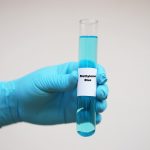After amino acids have been taken up into muscle tissue, they serve two basic purposes with respect to muscle conditioning.
The first, and most essential, is to become cellular catalysts. Such catalysts are used at the intracellular level, such as transcribing proteins. Their rate of depletion is directly associated with both the amount and the duration of the cellular work they perform.
Without these catalysts, muscle fibers would be unable to function. In order of precedence, then, the body values amino acids as catalyst replacements over their use as material for tissue repair.
It is this secondary function, that of the body’s use of “surplus” amino acids as building blocks to fashion and repair bodily tissues, that is achieved through the process of protein synthesis.
The Basics of Protein
Proteins are often referred to as the “building blocks” of the body, and for good reason. Unlike other macronutrients that can be “turned over” internally, there needs to be an incoming supply of this raw material in order to make up amount lost through the process of degradation. Since the body cannot store the individual amino acids that make up proteins, it collects them in and exchanges them among the liver, the blood and in the spaces surrounding individual muscles fibers, known as interstitial spaces.
Protein Structure
Amino acids rarely serve a function on their own and are most often put to work in combinations. From a chemical standpoint, all of them contain an amino group (NH2) with an acid end (COOH), as well as some component that sets them apart from each other. Some of these latter components include glucogenic groups, some contain sulfur and there are some that are known as branched-chain aminos based on their chemical structure. There are 21 unique amino acids present in the human body, ten of which are essential for bodily function in adults and cannot be synthesized by the body.
These are:
- Phenylalanine
- Valine
- Threonine
- Tryptophan
- Isoleucine
- Methionine
- Histidine
- Arginine
- Leucine
- Lysine
As a practical matter, histidine and arginine are required by infants and growing children. The amino acids leucine, isoleucine and valine are believed to account for approximately 60% of muscle tissue. Consequently, it is believed that it is these amino acids that are most readily taken up and converted into catalysts, sparing other amino acids in the process for use in protein synthesis and in energy production.
A protein containing essential amino acids is known as a “complete protein”. If one or more of those amino acids are missing, it is known as an “incomplete protein”.
While many people are concerned about the ratio of complete proteins in their meals, or the ratio of complementary proteins, it is important to realize the body can draw from a pool of amino acids within a given muscle.
Exercise Duration & Catalyst Depletion
If a given exercise lasts too long, the supply of ready formed catalysts is exhausted and the cells turn to converting amino acids that had been destined for use in protein synthesis. This is because the catalyst function is necessary for survival, while protein synthesis can wait, as far as the body is concerned. So the amino acids that have already been absorbed in the tissues are the first up for use as catalysts. In the event that there is an insufficient amount of amino acids, it is the muscle tissue itself that will be used through a process known as gluconeogeneis. From a training perspective, this constitutes overtraining and is generally to be avoided.
Avoiding Catalyst Depletion
Perhaps the easiest way to sidestep the issue of catalyst depletion altogether is ensure that he or she consumes an adequate amount of calories every 3 to 4 hours. Since the body’s “go-to” source of energy is carbohydrates, it is important that he or she consumes an amount of carbohydrate to spare protein.
In addition to nutritive considerations, the workout itself should not overly exertive. This will allow for the availability of sufficient post-workout recovery catalysts and energy being the process of anabolism in which the body grows new cells and maintains tissues, and slows the process of continued catabolism, or tissue breakdown.






